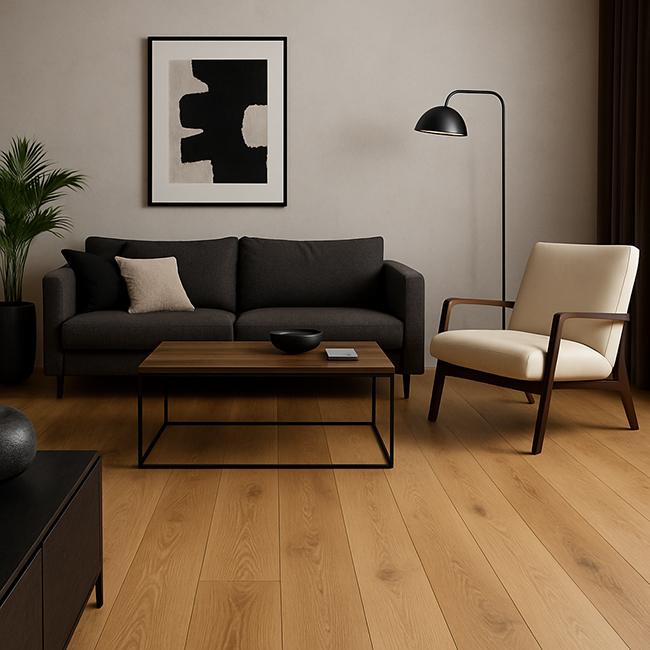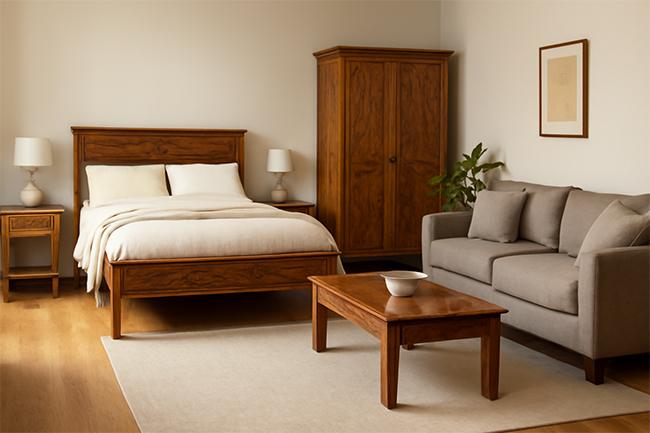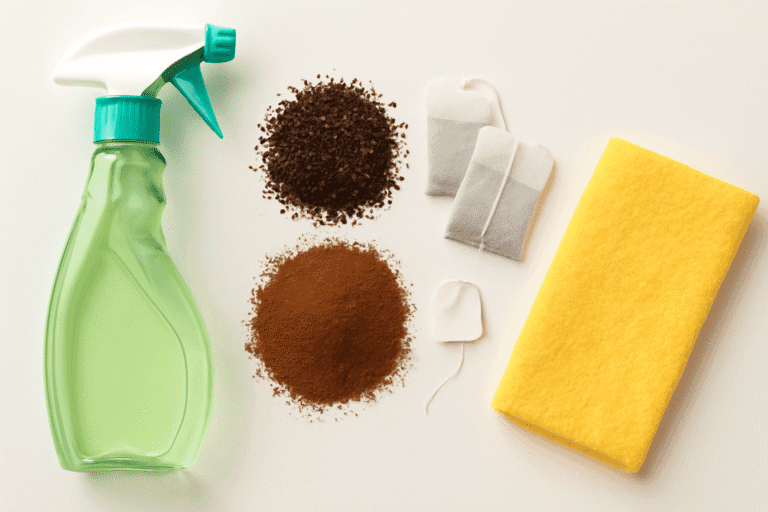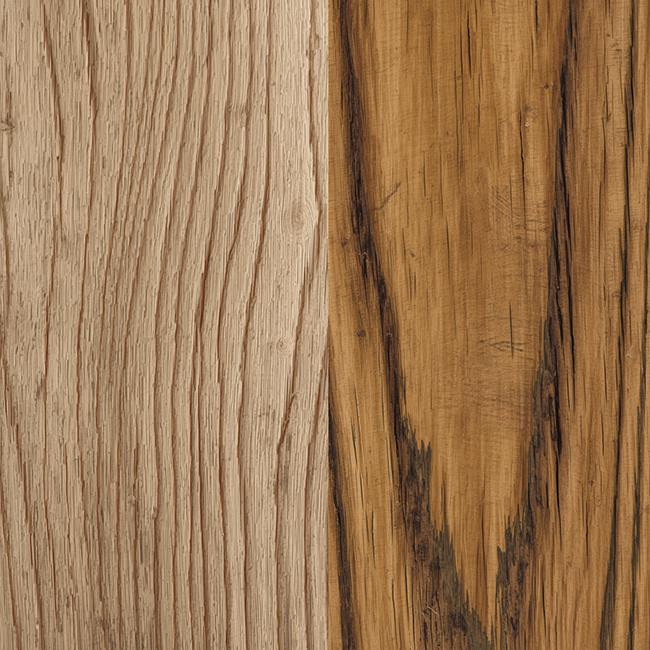Selecting the Best Oak Flooring: A Formula
Choosing the right oak flooring can be guided by this formula:
(Furniture tone + Room lighting + Room size + Planned style) = Best flooring option
Questions to Help Me Suggest the Best oak flooring Options
To provide you with the best recommendation, I need to know the following:
- What’s the tone of your oak furniture?
Is it light oak, medium oak, or dark oak? (For example, is it more golden/honey, has a red undertone, or is it darker brown?) - How much natural light does the room get?
How many windows are there, and which direction do they face (east, west, north, or south)? Does the room get a lot of sunlight or stay more shaded? - What type of artificial lighting do you have?
Are you using warm bulbs (yellowish light), cool white bulbs, or a mix of both? - What final look are you going for?
Do you want a modern/minimalist, rustic, cozy, Scandinavian, farmhouse, or bold & dramatic style? - What’s the size of the room?
Is it a small room or a larger space?
Why choosing Oak Flooring Depends on These Factors
Selecting the right oak flooring is influenced by a few key factors:
1. Oak Furniture Tone
The tone of your furniture and flooring should balance each other. If they’re too similar or too different, it can create a mismatch. Finding harmony is key.
2. Room Lighting (Natural + Artificial)
In rooms with less natural light, go for lighter flooring to brighten the space. For rooms with plenty of light, darker oak can add warmth.
3. Final / Planned Look (Style)
Your flooring sets the visual base for the room. Whether it’s modern, rustic, or cozy, the flooring should support the style you’re aiming for.
4. Room Size
- Small Room: Lighter flooring and wall colors make the room feel bigger.
- Large Room: Darker floors can add coziness and make the space feel more grounded.
5. Maintenance & Practical Use
- Light Floors: Show dirt and scratches more.
- Dark Floors: Show dust and white marks.
- Medium Tones: Provide a good balance and are easier to maintain.
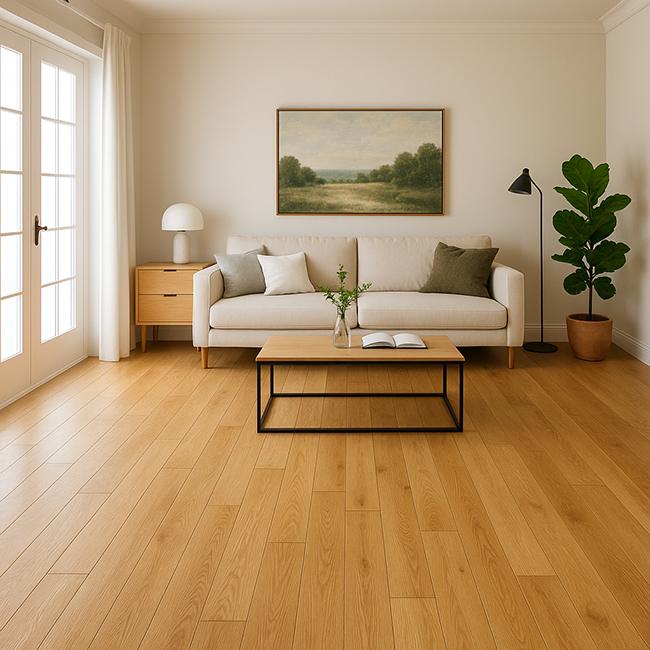
How to Choose the Best Oak Flooring?
When choosing oak flooring, don’t consider it in isolation. It’s essential to create a balance between the flooring and other elements like furniture, walls, rugs, and décor.
The flooring should complement and enhance these features rather than clash with them.
For example, if your furniture is dark oak, lighter flooring might create a nice contrast, while a minimalist room with light walls might benefit from a subtle, medium oak flooring for a balanced look.
By carefully considering the entire room’s design, you’ll find the perfect combination that ties everything together, creating a cohesive and harmonious space.
3 Useful Scenarios
Let me show you 3 sample scenarios. In each case, I’ll consider the combination of oak furniture, lighting, and the planned look, then suggest the best flooring option:
Scenario 1: choosing Light Oak Furniture (Pale/Honey Color)
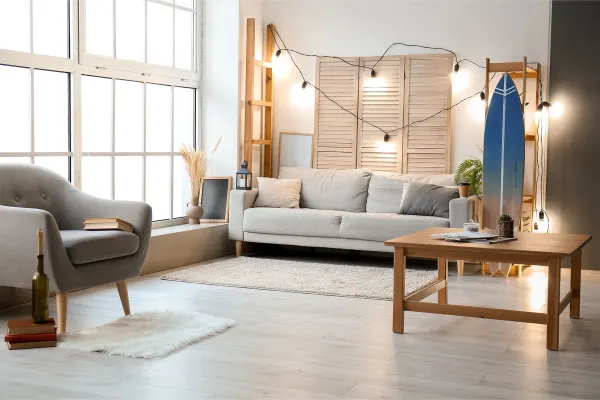
Furniture:
Choose light oak furniture (in a pale or honey tone). This type of wood naturally brightens up a room.
Room Lighting:
If the room has limited sunlight or only one or two windows, the lighting can feel a bit dim.
Planned Look:
You’re aiming for an airy, fresh, and modern style—something like Scandinavian design.
Flooring:
Opt for light-colored flooring such as white-wash oak, cream, light grey, or beige.
A matte or satin finish would be great, as it will reflect light.
Rugs:
Use rugs in soft cream or grey tones to complement the space.
Result:
The room will feel brighter, more open, and fresher. The furniture and flooring will be in a similar color family, but the floor will be a bit lighter, which helps create a nice balance.
Scenario 2: choosing Medium Oak Furniture (Amber/Golden Color)
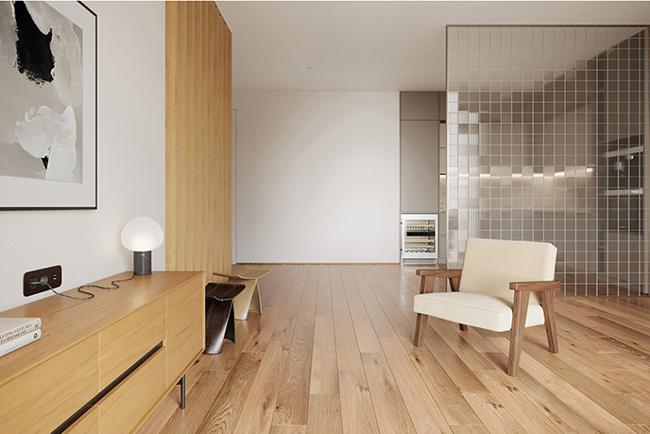
Furniture:
Choose medium oak furniture (amber or golden tone). It has a warm, rich tone that adds comfort to the space.
Room Lighting:
The room has normal lighting—not too bright, but not too dark either.
Planned Look:
You’re going for a cozy, rustic, or farmhouse style for a homey feel.
Flooring:
Select medium brown or honey oak flooring.
A textured or matte finish will give it that rustic charm.
Rugs:
Pick rugs in earth tones like terracotta, muted green, or brown to enhance the warm vibe.
Result:
The room will feel warm and cozy. Both the furniture and flooring will belong to the same warm color family, bringing comfort and a welcoming atmosphere to your home.
Scenario 3: choosing Dark Oak Furniture (Espresso/Deep Brown Color)
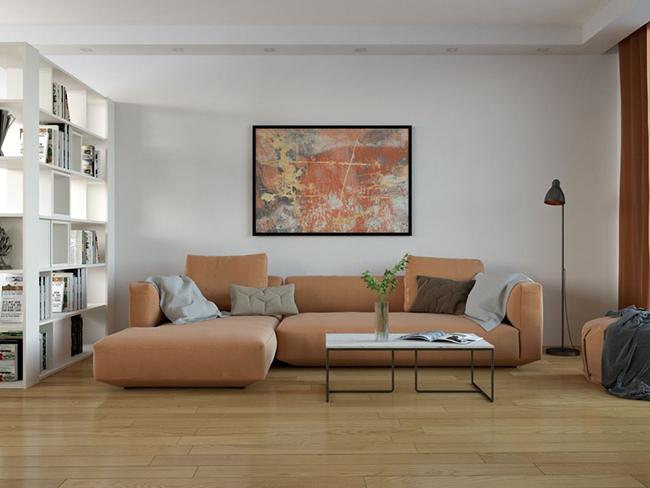
Furniture:
Choose dark oak furniture (espresso or deep brown). It has a strong and heavy appearance.
Room Lighting:
This works best if the room is large and has plenty of natural light.
Planned Look:
You’re aiming for an elegant, formal, or luxury style to give the space a refined feel.
Flooring:
Go for light-colored flooring, such as beige, cream, light greige, or light golden oak.
A glossy finish will work well if you want to add a luxury touch.
Walls:
Keep the walls light, like white or cream, and consider adding metallic décor elements (gold or silver) for an upscale look.
Result:
The dark furniture will stand out strongly, and the room will feel elegant and classy. It won’t feel heavy or dull, as the light flooring provides a nice contrast.
Simple Rule to Remember while choose oak flooring:
Light Furniture:
Light or dark flooring works well with light furniture, depending on the mood you want for the room.
Medium Furniture:
Warm flooring is best for a cozy look when paired with medium furniture.
Dark Furniture:
Light flooring is always the best choice with dark furniture, otherwise, the room may feel dark and heavy.
Don’t think of oak flooring on its own—create a balance with the furniture, walls, rugs, and décor. That’s how you’ll get the perfect combination
How to Create the Best Combination with Oak Flooring:
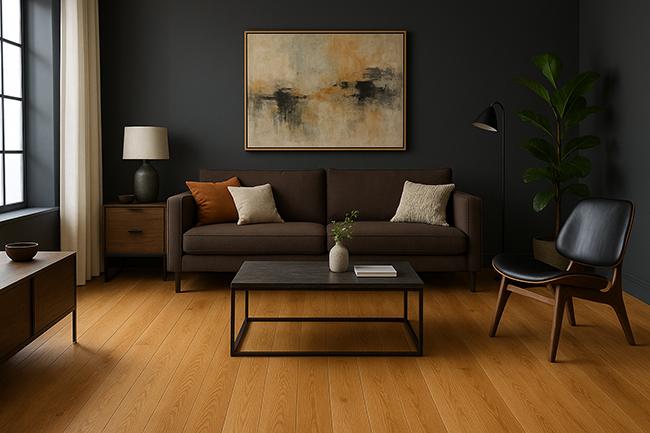
1. The Contrast Rule:
Make sure the flooring, furniture, and walls are not in the same tone.
Example:
- If the oak flooring is medium or dark, keep the walls light (white, cream, or pastel shades).
- If the oak flooring is light, choose furniture in darker tones (like walnut, black, or navy).
2. Add Accent Colors:
To keep the room from feeling dull, add a pop of color through cushions, rugs, or curtains.
Example:
- Light oak flooring + beige walls → Add emerald green cushions or a navy rug.
- Dark oak flooring + white walls → Use golden or rust-toned décor.
3. Mix Textures:
A room with just wood and paint can feel flat. To create a richer atmosphere, mix in different textures:
- Rugs: Soft textures like wool or cotton add comfort and warmth.
- Curtains: Choose linen for a light feel or velvet for a more luxurious touch.
- Lamps: Metal or glass lamps bring a modern contrast and shine.
This mix of textures will make the room feel more inviting and balanced.
4. Balance Dark & Light:
For a well-balanced room, it’s important to consider the contrast between light and dark elements:
- If the flooring is dark, make sure at least one large item in the room (such as the walls, curtains, or rug) is light. This helps avoid the room feeling too heavy or cramped.
- If the flooring is light, you should balance it by incorporating at least one dark piece of furniture, like the sofa, dining table, or bed frame. This prevents the room from feeling too bright or washed out.
Don’t just focus on oak flooring alone
Don’t just focus on oak flooring alone—it’s only one piece of the puzzle. To truly make the space feel complete and inviting, balance it with carefully chosen furniture, walls, rugs, and décor.
When everything works together, you’ll create a space that feels harmonious, warm, and effortlessly stylish.
some Examples and Key Takeaways
Warm and Bright Room with Light to Medium Golden Oak Flooring
- The flooring is a light to medium golden oak tone.
- The furniture and décor are also in warm tones (garnet-brown furniture, beige cushions, etc.).
- The walls and soft furnishings are light, making the room feel bright.
What Works Well:
The combination of light flooring, warm furniture, and light walls comes together beautifully, making the room feel both cozy and bright. This balance creates an inviting and comfortable atmosphere.
How It Works for You:
If your furniture is medium or light oak and the room has good lighting, you can easily reproduce this style. It will make your space feel open, warm, and welcoming.
Room with Textured Oak Flooring and Neutral Décor
- The flooring has a slightly patterned or textured oak finish with a medium golden tone.
- The furniture is simple with neutral colors, and a soft rug adds contrast and warmth.
What Works Well:
The patterned or textured flooring prevents the space from feeling boring. The light-colored décor, combined with the rug, creates a beautiful match between the flooring and furniture.
How You Can Try This in Your Room:
If you like patterns, choose simple rugs and décor to allow the texture of the flooring to shine. This way, the unique pattern of the oak flooring becomes the focal point, while the rest of the room remains balanced.
Earthy and Warm Room with Honey Oak Flooring and Greenery
- The room features honey oak flooring paired with warm-toned furniture (medium oak or wooden pieces).
- There are some green plants, and the room benefits from plenty of natural light with light-colored walls.
What Works Well:
The natural elements (plants, wood) along with the greenery accent and lighting create an earthy, warm vibe in the room. The balance of nature and light brings a refreshing, cozy feel.
How You Can Try This in Your Room:
Whether your furniture is warm oak or a bit darker, consider adding a light accent wall or décor item—like a green plant or a colorful cushion—to enhance the natural, inviting feel.
Bright and Minimalist Room with Light Oak Flooring
- The flooring is light oak or a light wood tone.
- The furniture is light and neutral, with minimal décor.
- The room is very bright, benefiting from natural light.
What Works Well:
This simple, minimalist setup lets the flooring take center stage, while the subtle furniture and décor help keep the focus on the flooring without overwhelming the space.
How You Can Try This in Your Room:
If you want the flooring to be the most prominent feature, keep the furniture and décor simple. This approach will let the flooring stand out and create a clean, airy feel in the room.
Room Ideas Based on These Examples
If your furniture is warm/medium oak:
Try flooring with a bit of texture or pattern to add depth. Keep the walls light for contrast, letting the furniture and flooring balance each other.
If the room has limited light:
Opt for lighter flooring or furniture with darker accents. This way, you can make the most of the available light and create a cozy yet open feel.
Use rugs, plants, and décor accents
Use rugs, plants, and décor accents to add contrast and personality. These elements bring warmth and individuality, enhancing the overall look of your space.
Pro Tips: The 3 Flooring Rule
What Does the “3 Flooring Rule” Mean?
The “3 Flooring Rule” is a common interior design concept. It means that in a house or apartment, you should use no more than three different types of flooring.
👉 Example:
- Living Room: Wooden flooring
- Kitchen: Tiles
- Bedrooms: Carpet
This variety works well. If each room has a different type of flooring, the house can feel disjointed, and the flow is lost. The rule helps maintain a cohesive and balanced look throughout the entire home.
Can the 3 Flooring Rule Be Applied with Oak Flooring?
Yes, absolutely! 👍 The 3 Flooring Rule can definitely be applied with oak flooring. This means you can use oak as the base flooring and choose two other materials or variations for different areas.
👉 Example:
- Living Room + Bedrooms: Oak flooring (this creates a consistent flow throughout the rooms)
- Kitchen: Ceramic or Porcelain tiles (water-resistant for practical use)
- Bathrooms: Marble or Vinyl tiles (slip-resistant for safety)
This way, the warm look of oak remains consistent throughout the home, while different flooring materials are used in functional areas like the kitchen and bathroom.
What is the Best Thickness for Oak Flooring?
1. Solid Oak Flooring
- Standard Thickness: 18mm – 20mm
- Why it’s Great: Extremely durable and can be sanded and refinished multiple times.
- Ideal For: Long-term use (50+ years). Best choice for lasting quality.
Solid oak flooring is the traditional gold standard for hardwood floors.
2. Engineered Oak Flooring
Engineered hardwood flooring is typically made from seven to ten layers of thin veneers or sheets, glued together to form a type of plywood.
- Standard Thickness: 12mm – 15mm (overall)
- Top Oak Wear Layer: 3mm – 6mm
- Why it’s Great: More stable than solid oak, as it doesn’t warp or twist with temperature and humidity changes.
- Ideal For: Modern homes, especially with underfloor heating.
3. Laminate Oak Look Flooring (if you don’t need real oak)
- Thickness: 8mm – 12mm
- Why it’s Great: Budget-friendly, though it doesn’t have the same lifespan or feel as real oak.
If you want long-term durability and a luxury look, go for 18–20mm solid oak.
For a practical, budget-friendly, and modern setup, 14–15mm engineered oak with a 4mm wear layer is the best choice.
Whether you have solid oak, antique, or light oak furniture, maintaining their appearance is crucial. Learn the best cleaning practices in our how to clean oak furniture guide.
Are There Any Disadvantages to Oak Flooring?
Yes, definitely! 👍 While oak flooring has many advantages, there are a few disadvantages to keep in mind when making your decision:
Disadvantages of Oak Flooring
Expensive:
Oak is a premium hardwood, so it costs more compared to laminate or vinyl flooring.
Scratch & Dent Issues:
Heavy furniture or sharp objects can cause scratches and dents. This is especially a concern if you have small children or pets in the house.
Janka hardness test measures the resistance of a sample of wood to denting and wear.
Moisture Sensitivity:
Excess moisture or humidity can cause oak to swell or warp. This makes it risky for areas like bathrooms, kitchens, and basements.
Maintenance Required:
Regular cleaning is necessary, and occasional polishing or refinishing is needed to keep the shine. Without maintenance, the floor can lose its luster.
Proper maintenance is essential for the longevity of your oak flooring. For detailed cleaning instructions, refer to our guide on how to clean oak furniture.
Sunlight Effect:
Direct sunlight can cause oak flooring to fade or turn yellowish over time. Using curtains or blinds will help protect it from sun damage.
Hard Surface:
Oak flooring can feel hard underfoot, unlike vinyl or laminate, which provide softer comfort. Standing or walking for long periods may be less comfortable.
In conclusion:
Oak flooring is classy and durable, but it’s important to consider the budget, maintenance, and the environment of the area before installing it.
Flooring Comparison Chart
| Flooring Type | 👍 Advantages | ❌ Disadvantages | 💰 Cost (Approx) |
|---|---|---|---|
| Oak (Hardwood) | – Natural, elegant look- Durable (lasts for decades)- Can be refinished (polished again)- Adds value to the home | – Expensive- Scratches & dents easily- Moisture sensitive- Requires regular maintenance | High |
| Laminate | – Budget-friendly- Scratch resistant- Wide variety of designs- Easy installation | – Doesn’t have the real wood look (artificial feel)- Cannot be repaired/refinished- Can swell with moisture | Low–Medium |
| Vinyl (LVP/LVT) | – Waterproof (safe for bathroom/kitchen)- Affordable- Soft underfoot- Easy to maintain | – Doesn’t have the natural hardwood look- Lower long-term durability- Cheap vinyl can wear quickly | Low–Medium |
| Tiles (Ceramic/Porcelain) | – 100% waterproof- Extremely durable- Very low maintenance- Variety of styles & colors | – Cold & hard surface- Not very comfortable to walk on- Grout cleaning can be tricky- Installation can be expensive | Medium–High |
| Engineered Wood | – Real wood top layer (natural look)- Better moisture resistance than solid oak- Cheaper than hardwood- More affordable than laminate & vinyl | – Limited refinishing options- Still more expensive than laminate/vinyl- Not as durable as solid oak | Medium–High |
Simple Understanding:
- Want a natural look but with a smaller budget: Go for Engineered Wood.
- Want luxury & long-term investment: Go for Oak.
- Need a budget-friendly option with a decent look: Choose Laminate.
- For water areas (kitchen/bathroom): Opt for Vinyl or Tiles.

